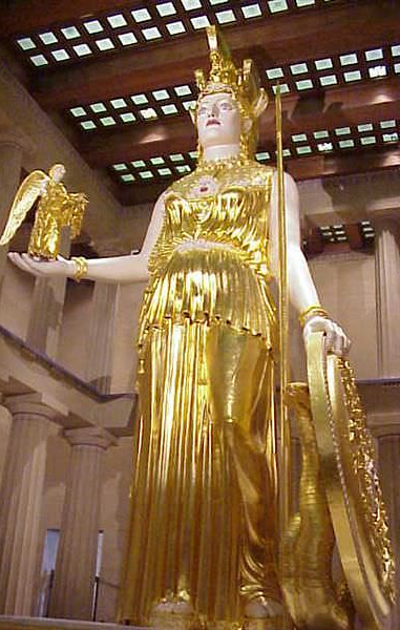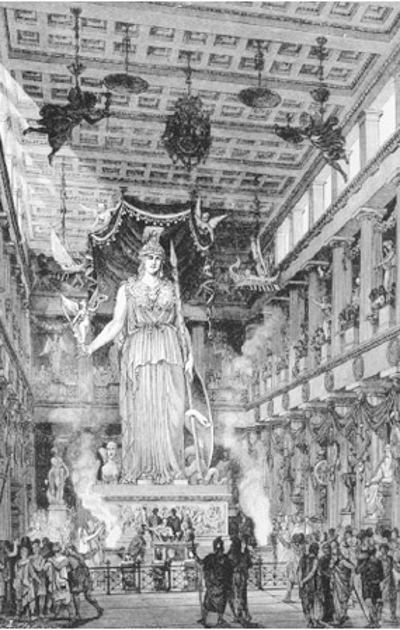Classical Greek Travel Log
I had decided to take a trip to Greece during the classical period to visit temples and monuments to the Gods of Olympus. I had heard that these sites were very beautiful and monumental so I decided to go visit them to see for myself, and I was not disappointed. On the first stop of my trip to Ancient Greece, I wanted to visit the statue of Athena which was located in the Parthenon. Unfortunately, I was not allowed to see the actual statue due to the fact that the statue was not allowed to be viewed publicly.
Instead, I was allowed to visit the wooden statue of Athena, which was located in the Erechtheion. The Erechtheion was located north of the Parthenon, so I traveled there in hopes of seeing something similar to the actual statue. When I arrived, I witnessed Athenian citizens worshipping the the wooden statue of Athena. I had asked a local Athenian if he knew what the actual statue looked like and I was told that the actual statue stood around 40 feet tall. It was made of gold and Ivory with a wooden core, once I heard all of this the wooden statue was very underwhelming.
As I was looking at the wooden statue, I overheard two Athenian men talk about a situation involving the Sculptor of the original statue Pheidias. I had heard that he was accused of stealing chunks of gold that where meant for the statue and that him and his mentor could be the reasons for a war that is started to brew. I had asked these Athenians why he had built the sculpture in the first place. They told me that there was a war between them and Persia, which they had won, and he built the statue as an ode to the goddess Athena because he believed Athens to be the greatest city in Greece.
Sources:
Primary- Oldfather, C. H., trans. “Diodorus Siculus, Library.” Diodorus Siculus, Library, Book XII, Chapter 39. Harvard University Press. Accessed November 27, 2022. http://www.perseus.tufts.edu/hopper/text?doc=Perseus%3Atext%3A1999.01.0084%3Abook%3D12%3Achapter%3D39.
Secondary- Evans, James Allen . "Temples and Shrines in the Hellenistic Age." In Daily Life through History, ABC-CLIO, 2022. Accessed November 27, 2022. https://dailylife2-abc-clio-com.eznvcc.vccs.edu/Search/Display/1437675.
Robel Wendweson
5 chapters
28 Nov 2022
The Statue of Athena
November 28, 2022
|
Athens, Greece
I had decided to take a trip to Greece during the classical period to visit temples and monuments to the Gods of Olympus. I had heard that these sites were very beautiful and monumental so I decided to go visit them to see for myself, and I was not disappointed. On the first stop of my trip to Ancient Greece, I wanted to visit the statue of Athena which was located in the Parthenon. Unfortunately, I was not allowed to see the actual statue due to the fact that the statue was not allowed to be viewed publicly.
Instead, I was allowed to visit the wooden statue of Athena, which was located in the Erechtheion. The Erechtheion was located north of the Parthenon, so I traveled there in hopes of seeing something similar to the actual statue. When I arrived, I witnessed Athenian citizens worshipping the the wooden statue of Athena. I had asked a local Athenian if he knew what the actual statue looked like and I was told that the actual statue stood around 40 feet tall. It was made of gold and Ivory with a wooden core, once I heard all of this the wooden statue was very underwhelming.
As I was looking at the wooden statue, I overheard two Athenian men talk about a situation involving the Sculptor of the original statue Pheidias. I had heard that he was accused of stealing chunks of gold that where meant for the statue and that him and his mentor could be the reasons for a war that is started to brew. I had asked these Athenians why he had built the sculpture in the first place. They told me that there was a war between them and Persia, which they had won, and he built the statue as an ode to the goddess Athena because he believed Athens to be the greatest city in Greece.
Sources:
Primary- Oldfather, C. H., trans. “Diodorus Siculus, Library.” Diodorus Siculus, Library, Book XII, Chapter 39. Harvard University Press. Accessed November 27, 2022. http://www.perseus.tufts.edu/hopper/text?doc=Perseus%3Atext%3A1999.01.0084%3Abook%3D12%3Achapter%3D39.
Secondary- Evans, James Allen . "Temples and Shrines in the Hellenistic Age." In Daily Life through History, ABC-CLIO, 2022. Accessed November 27, 2022. https://dailylife2-abc-clio-com.eznvcc.vccs.edu/Search/Display/1437675.


Share your travel adventures like this!
Create your own travel blog in one step
Share with friends and family to follow your journey
Easy set up, no technical knowledge needed and unlimited storage!